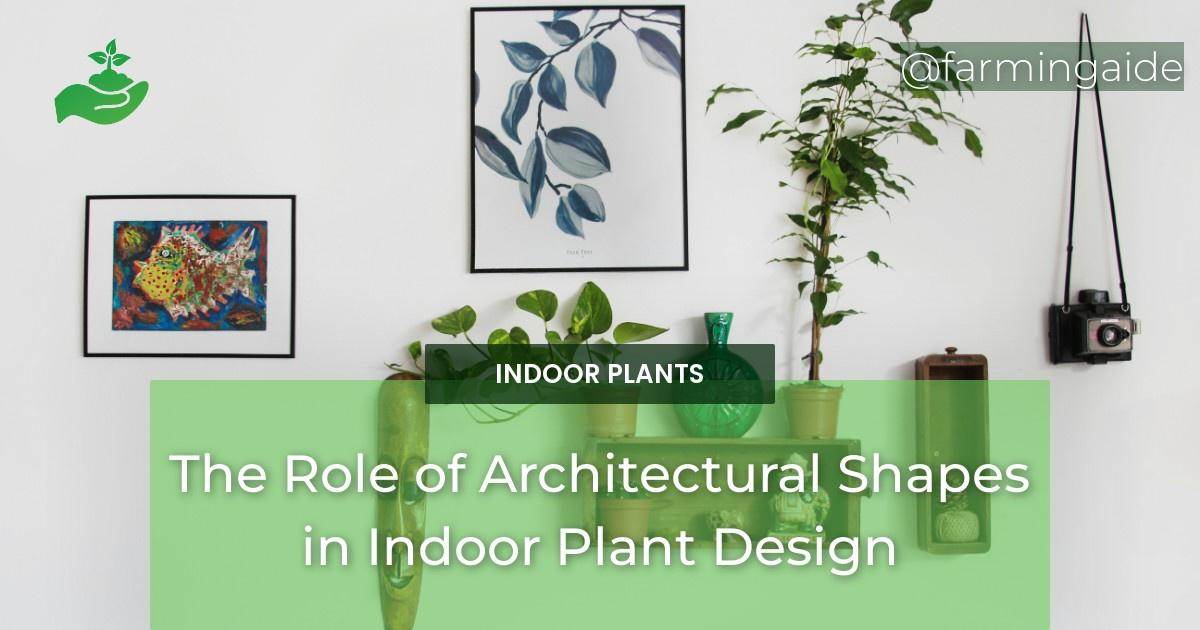The role of architectural shapes in indoor plant design is often overlooked, yet it plays a crucial role in creating a stunning and functional indoor plant display. By incorporating different shapes into your plant design, you can enhance the aesthetic appeal, promote better air circulation, provide support and structure for plants, and create a sense of balance and harmony in your space. In this article, we will dive deeper into the importance and impact of architectural shapes in indoor plant design, explore popular shapes for indoor plants, and provide tips on how to use them effectively. So, whether you are a seasoned indoor gardener or just starting out, read on to discover the benefits of incorporating architectural shapes in your indoor plant design.
Table of Contents
Understanding the Importance of Architectural Shapes in Indoor Plant Design
Architectural shapes refer to the form and structure of a plant, which can range from tall and narrow to round and compact. They are an important element in indoor plant design as they not only add visual interest and variety to a space, but also serve functional purposes. For instance, choosing the right shape can impact the growth and health of your plants, as well as the overall aesthetics of your indoor space.
The Impact of Architectural Shapes on Indoor Plant Growth
Architectural shapes can influence the growth and development of indoor plants in various ways. For example, tall and narrow shapes can help plants grow taller and reach for light, while cascading and trailing shapes can encourage a fuller and more lush growth. Additionally, certain shapes may provide better support for specific types of plants, allowing them to thrive and reach their full potential.
Benefits of Incorporating Architectural Shapes in Indoor Plant Design
Enhancing Aesthetic Appeal
One of the main benefits of incorporating architectural shapes in indoor plant design is the enhancement of aesthetic appeal. By carefully selecting and grouping plants with different shapes, you can create a visually appealing and dynamic display that adds character and personality to your space. Moreover, using a variety of shapes can prevent your indoor plant display from looking monotonous or cluttered.
ALSO READ
Promoting Better Air Circulation
Another advantage of utilizing architectural shapes in indoor plant design is the promotion of better air circulation. By choosing plants with open and airy shapes, you can improve the flow of air in your space, which is crucial for maintaining healthy and thriving plants. This is especially important in indoor environments where air circulation may be limited.
Providing Support and Structure for Plants
Architectural shapes also play a functional role in providing support and structure for plants. For instance, plants with tall and narrow shapes can benefit from a trellis or support structure to prevent them from toppling over. Likewise, trailing and cascading shapes may require hanging baskets or planters to support their growth and prevent them from becoming tangled or damaged.
ALSO READ
Creating a Sense of Balance and Harmony
Incorporating architectural shapes in indoor plant design can also help create a sense of balance and harmony in your space. By combining plants with different shapes, you can create a visually appealing composition that is pleasing to the eye and promotes a sense of balance and harmony. This is especially important in small spaces where a sense of balance and proportion can make a big difference.
Utilizing Limited Space Efficiently
For those with limited space, architectural shapes can be a game-changer in indoor plant design. By choosing plants with compact and round shapes, you can effectively utilize small spaces and still have a beautiful and diverse plant display. This is also a great way to add greenery to areas that may not have enough room for larger plants.
Adding Visual Interest and Variety to Indoor Spaces
Last but not least, incorporating architectural shapes in indoor plant design is a great way to add visual interest and variety to your indoor spaces. By experimenting with different shapes, you can create a unique and dynamic display that reflects your personal style and adds character to your home or office.
Popular Architectural Shapes for Indoor Plants
Tall and Narrow Shapes
Plants with tall and narrow shapes, such as bamboo or snake plants, are great for adding height and drama to your indoor space. They are also ideal for creating a vertical garden in small spaces.
Cascading and Trailing Shapes
Plants with cascading and trailing shapes, such as ivy or spider plants, are perfect for adding a touch of greenery to shelves, bookcases, or hanging planters. They can also be used to create a lush and full display when grouped together.
Round and Compact Shapes
Plants with round and compact shapes, such as succulents or cacti, are great for adding texture and dimension to your indoor space. They are also perfect for grouping together in a variety of containers for a dynamic and visually appealing display.
Pyramid and Cone Shapes
Plants with pyramid and cone shapes, such as yucca or ficus trees, are ideal for creating a focal point in your space. They can also be used to add a touch of height and structure to your indoor plant display.
Geometric and Angular Shapes
Plants with geometric and angular shapes, such as aloe or air plants, are great for adding a modern and unique touch to your indoor space. They can also be used to create a contrast with softer and rounder shapes for a more dynamic composition.
Spherical and Orb-Shaped
Plants with spherical and orb-shaped, such as marimo or moss balls, are perfect for adding a touch of whimsy and uniqueness to your indoor space. They can also be used to create a cohesive and balanced display when grouped together in different sizes.
How to Use Architectural Shapes in Indoor Plant Design
Consider the Plant’s Natural Growth Habit
When incorporating architectural shapes in your indoor plant design, it is important to consider the plant’s natural growth habit. This will help you choose the right shape for the plant and ensure its proper growth and development. For instance, a plant with a sprawling growth habit may not do well in a tall and narrow shape, while a plant with a climbing habit may thrive in a cascading or trailing shape.
Choose Complementary Shapes for Grouping Plants
When grouping plants together, it is important to choose complementary shapes to create a cohesive and balanced display. For example, you can pair a tall and narrow plant with a round and compact plant, or a cascading plant with an angular and geometric plant.
Use a Variety of Shapes for a Dynamic Display
To create a visually appealing and dynamic display, it is important to use a variety of shapes in your indoor plant design. This will prevent your display from looking monotonous or cluttered and add visual interest and variety to your space.
Experiment with Different Containers and Planters
Architectural shapes can also be incorporated into your indoor plant design through the use of different containers and planters. For instance, a tall and narrow plant can be placed in a tall and slim planter, while a round and compact plant can be placed in a spherical or orb-shaped planter.
Incorporate Architectural Shapes into Vertical Gardens
Vertical gardens are a great way to utilize limited space and incorporate architectural shapes into your indoor plant design. You can use a variety of shapes, such as cascading, round, and angular, to create a stunning and functional vertical display.
Use Lighting to Highlight Architectural Shapes
Lighting can also play a role in highlighting the architectural shapes in your indoor plant design. By using spotlights or accent lighting, you can draw attention to specific shapes and create a focal point in your space.
Enhancing the Aesthetic Appeal of Indoor Plants with Architectural Shapes
Creating Focal Points and Points of Interest
Architectural shapes are a great way to create focal points and points of interest in your indoor space. By choosing plants with unique and eye-catching shapes, you can draw attention to specific areas and add a touch of drama to your space.
Adding Texture and Dimension to Indoor Spaces
Incorporating different shapes in your indoor plant design is also a great way to add texture and dimension to your space. This is especially important in minimalist or monochromatic spaces where plants can add a natural and organic element.
Complementing Existing Décor and Design Elements
Architectural shapes can also be used to complement existing décor and design elements in your space. For instance, a round and compact plant can be placed on a sleek and angular table for a contrast in shapes, or a tall and narrow plant can be placed next to a tall and slim sculpture for a cohesive display.
Incorporating Personal Style and Preferences
By choosing plants with different architectural shapes, you can incorporate your personal style and preferences into your indoor plant design. For example, if you prefer a modern and minimalistic aesthetic, you can opt for plants with geometric and angular shapes, while those who prefer a more whimsical and eclectic style can choose plants with spherical and orb-shaped.
Creating a Cohesive and Balanced Indoor Plant Design
Last but not least, incorporating architectural shapes in your indoor plant design can help create a cohesive and balanced display. By considering the different shapes and their placement in your space, you can create a harmonious and visually appealing composition that ties your indoor plants together.
How Can Architectural Shapes Enhance Indoor Plant Arrangements?
Architectural shapes can play a crucial role in creating stylish indoor plant arrangements. Using geometric planters, hanging planters, or shelves with different shapes can add visual interest and complement the overall design of a space. It also allows for more creativity and variation when arranging plants indoors.
Conclusion
Summarizing the Importance and Impact of Architectural Shapes in Indoor Plant Design
In conclusion, the role of architectural shapes in indoor plant design cannot be underestimated. From promoting better air circulation and providing support for plants, to adding visual interest and enhancing the aesthetic appeal of indoor spaces, architectural shapes play a crucial role in creating a stunning and functional indoor plant display.
Encouraging Experimentation and Creativity in Indoor Gardening
We hope this article has inspired you to experiment with different shapes in your indoor plant design and get creative with your plant displays. By considering the importance and impact of architectural shapes, you can take your indoor gardening to the next level and create a unique and dynamic display.
Emphasizing the Versatility and Benefits of Architectural Shapes in Indoor Plant Design
Lastly, it is important to note that architectural shapes are versatile and can be used in a variety of ways to enhance your indoor plant design. Whether you are working with limited space or looking to add a touch of personality to your space, incorporating different shapes is a great way to achieve your desired results.


